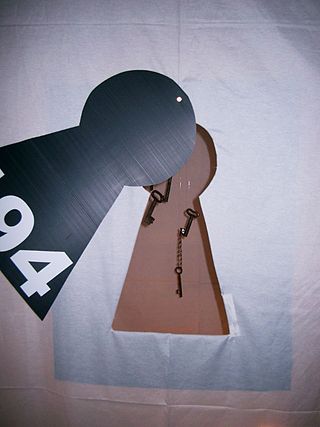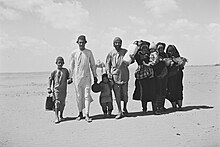Antisemitism has increased greatly in the Arab world since the beginning of the 20th century, for several reasons: the dissolution and breakdown of the Ottoman Empire and traditional Islamic society; European influence, brought about by Western imperialism and Arab Christians; Nazi propaganda and relations between Nazi Germany and the Arab world; resentment over Jewish nationalism; the rise of Arab nationalism; and the widespread proliferation of anti-Jewish and anti-Zionist conspiracy theories.

Zionism is a nationalist movement that emerged in the 19th century to enable the establishment of a homeland for the Jewish people in Palestine, a region roughly corresponding to the Land of Israel in Jewish tradition. Following the establishment of the modern state of Israel, Zionism became an ideology that supports the development and protection of the State of Israel as a Jewish state.
In the 20th century, approximately 900000 Jews migrated, fled, or were expelled from Muslim-majority countries throughout Africa and Asia. Primarily a consequence of the 1948 Arab–Israeli War, the mass movement mainly transpired from 1948 to the early 1970s, with one final exodus of Iranian Jews occurring shortly after the Islamic Revolution in 1979–1980. An estimated 650000 (72%) of these Jews resettled in Israel.
This article lists expulsions, refugee crises and other forms of displacement that have affected Jews.
Supremacism is the belief that a certain group of people is superior to all others. The supposed superior people can be defined by age, gender, race, ethnicity, religion, sexual orientation, language, social class, ideology, nationality, culture, or belong to any other part of a particular population.
Mizrahi Jews, also known as Mizrahim (מִזְרָחִים) or Mizrachi (מִזְרָחִי) and alternatively referred to as Oriental Jews or Edot HaMizrach, are a grouping of Jewish communities comprising those who remained in the Land of Israel and those who existed in diaspora throughout and around the Middle East and North Africa (MENA) from biblical times into the modern era.

Farhud was the pogrom or the "violent dispossession" that was carried out against the Jewish population of Baghdad, Iraq, on 1–2 June 1941, immediately following the British victory in the Anglo-Iraqi War. The riots occurred in a power vacuum that followed the collapse of the pro-Nazi government of Rashid Ali while the city was in a state of instability. The violence came immediately after the rapid defeat of Rashid Ali by British forces, whose earlier coup had generated a short period of national euphoria, and was fueled by allegations that Iraqi Jews had aided the British. More than 180 Jews were killed and 1,000 injured, although some non-Jewish rioters were also killed in the attempt to quell the violence. Looting of Jewish property took place and 900 Jewish homes were destroyed.
Arab Jews is a term for Jews living in or originating from the Arab world. The term is politically contested, often by Zionists or by Jews with roots in the Arab world who prefer to be identified as Mizrahi Jews. Many left or were expelled from Arab countries in the decades following the founding of Israel in 1948, and took up residence in Israel, Western Europe, the United States and Latin America.
From 1951 to 1952, Operation Ezra and Nehemiah airlifted between 120,000 and 130,000 Iraqi Jews to Israel via Iran and Cyprus. The massive emigration of Iraqi Jews was among the most climactic events of the Jewish exodus from the Muslim World.
Palestinian Jews or Jewish Palestinians were the Jewish inhabitants of the Palestine region prior to the establishment of the State of Israel in 1948.

The Palestinian right of return is the political position or principle that Palestinian refugees, both first-generation refugees and their descendants, have a right to return and a right to the property they themselves or their forebears left behind or were forced to leave in what is now Israel and the Palestinian territories during the 1948 Palestinian expulsion and flight and the 1967 Six-Day War.

The Van Leer Jerusalem Institute (VLJI) is a center for the interdisciplinary study and discussion of issues related to philosophy, society, culture, and education. The Institute was established in order to create a body of knowledge and discourse and to give expression to the wide range of disciplines and opinions in Israel. The contribution of a core of renowned scholars facilitates the implementation of reforms and new approaches in various social spheres.
Yehouda Shenhav is an Israeli sociologist and critical theorist. He is known for his contributions in the fields of bureaucracy, management and capitalism, as well as for his research on ethnicity in Israeli society and its relationship with the Israeli-Palestinian conflict.

In 1948, more than 700000 Palestinian Arabs – about half of prewar Mandatory Palestine's Arab population – fled from their homes or were expelled by Zionist militias and, later, the Israeli army during the 1948 Palestine war, following the Partition Plan for Palestine. The expulsion and flight was a central component of the fracturing, dispossession, and displacement of Palestinian society, known as the Nakba. Dozens of massacres were conducted by Israeli military forces and between 400 and 600 Palestinian villages were destroyed. Village wells were poisoned in a biological warfare programme and properties were looted to prevent Palestinian refugees from returning. Other sites were subject to Hebraization of Palestinian place names. These activities were not necessarily limited to the year 1948.

Conditions worsened for the Jews of Libya after the passage of Italy's Manifesto of Race in 1938. Following the German intervention in 1941, some Jews were sent to camps in continental Europe, where those who survived stayed until the end of World War II.

The One Million Plan was a strategic plan for the immigration and absorption of one million Jews from Europe, the Middle East, and North Africa into Mandatory Palestine, within a timeframe of 18 months, in order to establish a state in that territory. After being voted on by the Jewish Agency for Palestine Executive in 1944, it became the official policy of the Zionist leadership. Implementation of a significant part of the One Million Plan took place following the establishment of the State of Israel in 1948.
Mizrahi Jews constitute one of the largest Jewish ethnic divisions among Israeli Jews. Mizrahi Jews are descended from Jews in the Middle East, North Africa and Central Asia and parts of the Caucasus, who had lived for many generations under Muslim rule during the Middle Ages. The vast majority of them left the Muslim-majority countries during the Arab–Israeli conflict, in what is known as the Jewish exodus from Arab and Muslim countries.

Maurice M. Roumani, born in Benghazi, Libya, is Professor of Politics and International Relations, Religion and Society of the Middle East and the Founder of the J. R. Elyachar Center for Studies in Sephardi Heritage at Ben-Gurion University of the Negev in Israel. He specializes in Ethnic Relations in Israel, Jews of Arab countries, the Middle East Conflict, and he is an expert on the History of Libyan Jews, Jewish-Muslim Relations and the impact of Holocaust policies in North Africa.
The Nakba was the ethnic cleansing of Palestinians in Mandatory Palestine during the 1948 Palestine war through their violent displacement and dispossession of land, property and belongings, along with the destruction of their society, culture, identity, political rights, and national aspirations. The term is also used to described the ongoing persecution and displacement of Palestinians by Israel. As a whole, it covers the shattering of Palestinian society and the long-running rejection of the right of return for Palestinian refugees and their descendants.
Nakba denial is a form of historical denialism pertaining to the 1948 Palestinian expulsion and flight and its accompanying effects, which Palestinians refer to collectively as the "Nakba". Underlying assumptions of Nakba denial cited by scholars can include the denial of historically documented violence against Palestinians, the denial of a distinct Palestinian identity, the theory that Palestine was barren land, and the theory that Palestinian dispossession were part of mutual transfers between Arabs and Jews justified by war.








